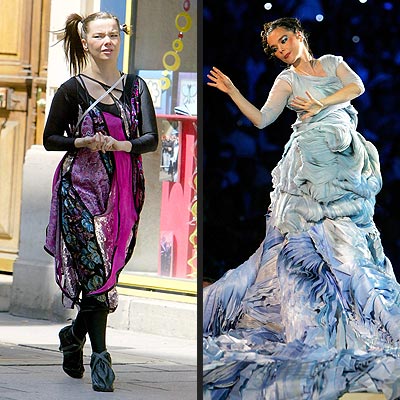Radical feminists have been pointing out for ages that the main issue of the patriarchy is that women are the sex class -- that is, whatever it is a woman does or doesn't do, it becomes interpreted in terms of sex or her suitability to be an object of desire. The very female form became so deeply sexualized in the society that it is synonymous with sex. Thus, for any woman in a public sphere, her body becomes an article that needs to be addressed somehow -- since this is what everyone will be talking about anyway. And as such, clothing becomes a set of signals and modifiers giving clues to how any body should be interpreted, and the designers are thus integral to the process.
It is not surprising (or interesting) to see that vast majority of starlets and pop singers aim for the traditionally feminine, sexy presentation, and most designers do the same. There's no commentary on patriarchy or even on the female body in the public sphere -- the body is presented as a straight up sex symbol, without subversion or irony. Be it Taylor Swift or Taylor Momsen, Chanel or Proenza Schouler -- the woman is pretty, the clothes are flattering, and the female form remains unchanged.
A very small minority goes the exactly opposite route -- denying traditional femininity completely; nothing symbolizes this sensibility better than Comme des Garcons designs:

In performers, we have Bjork:

While we can argue about relative attractiveness, I think an argument can be made that she is going for the opposite of the traditionally attractive, elegant, feminine.
Now McQueen and Lady Gaga represent the union of these two opposing esthetics: while they do not deny the female body, they distort it, sometimes subtly, sometimes not so. Both McQueen's models and Lady Gaga have appeared covered in blood, paint, with a variety of grotesque exaggerations:



(The last one, is of course, Lady Gaga wearing McQueen's famous armadillo shoes.)
It is easy to dismiss both as trying for 'shock value'; except, I think, this is way too simple. McQueen's shows has always been conceptual, and he has been accused of misogyny -- with show names like "Highland Rape", showing bloodied models in torn clothes, it is easy to see why. However, I have to argue that in its effect the show was in no way titillating but unpleasant. People who complained about it felt disturbed -- which is pretty much how rape supposed to make one feel. It seems more of a commentary on rape culture than endorsement of it (according to McQueen himself, he was referencing the rape of Scotland by England). Gaga, on the other hand, goes to great length to make herself more than just an extravagantly dressed starlet -- she uses her body not so much to seduce but to fascinate and repulse and question.
So I like both Gaga and McQueen just for that -- for not taking the easy road of sexy pouty elegance, for managing to appeal and repel at the same time, and for making a female body more than a vessel for sexual desire projected upon it by other people. And this, to me, is interesting avant garde.
After all, Bjork loved McQueen too.

No comments:
Post a Comment